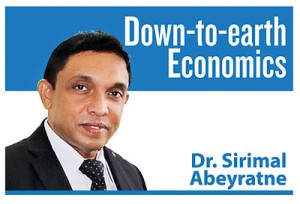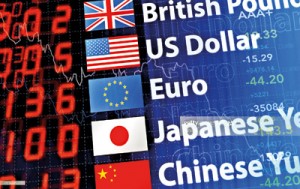“For a few dollars more”
View(s):
However, at a time that even unusually massive amounts of money have been pumped by the central banks in advanced countries such as the US the EU countries and Japan, how could it be an abnormal policy for a country like Sri Lanka, especially when there are no other options? The expectation of the policy is, anyway, helping people and businesses to keep the nose above water and stimulating the crisis-ridden economy.
I felt that it would be an incomplete discussion, if I don’t connect money-pumping to the “rupee-dollar” problem – the exchange rate. We know that the country needs dollars and other international currencies “coming in” to maintain the exchange rate. At the same time, the country must face foreign exchange “going out” pressurising the exchange rate. Inflows and outflows are the respective sources of the supply of and demand for foreign currency, which determines the daily exchange rate – the rupee price of a dollar.
Inflows and outflows
Before we turn to focus on “money-pumping and rupee-dollar problem”, let me elaborate on foreign exchange inflows and outflows over the past few months, impacting on the exchange rate. All major sources of Sri Lanka’s foreign exchange inflows were disrupted due to the global COVID-19 pandemic issue. During the first five months of the year (January-May), the pressure on the exchange rate was mounting due to a sudden fall in foreign exchange inflows as well as a sudden rise in outflows.
According to Central Bank data, on the inflow-side, export earnings declined by US$1,396 (28 per cent), tourism earnings by $826 million (46 per cent), and worker remittances by $326 million (12 per cent). On the other hand, foreign investment recorded a net outflow of $65 million from the Colombo Stock Exchange, and $454 million from government securities. Apart from that, we need to add the repayment of foreign loans this year as part of the outflows, and foreign borrowings as part of the inflows. The invitation, extended to Sri Lankans and well-wishers to deposit their foreign currency in special deposit accounts, is reported to have generated inflows no more than $87 million.
Import controls and exchange rate
As the main foreign exchange inflows collapsed, and outflows mounted, the government adopted stringent import controls, pushing the economy towards a near “closed economy”. It averted the pressure on the exchange rate temporarily, but still at a cost. All imports declined by $1,577 (19 per cent), while the decline in both intermediate goods and investment goods by more than 23 per cent was a notable change. The decline in import expenditure was also helped by the fall in world commodity prices, as a feature of a global recession. The fall in fuel prices which remain today around $40 a barrel, combined with the fall of local fuel demand helped the country to save $583 million.
In early March 2020, Sri Lanka’s exchange rate was Rs. 181 per US$, which shot up to almost Rs. 200 by early April. Then it declined to Rs. 185 by late May and, continued to remain around that figure up to-date. As and when necessary, the Central Bank too intervenes in order to maintain the exchange rate in absorbing from inflows and supplying for outflows.
During the first five months of the year, the Central Bank has supplied $335 million, out of which the biggest amounts have been pumped in March and April, when the exchange rate began to soar. It shows that the attempts to avert exchange rate pressure through import controls was not enough so that the Central Bank had to intervene too. On the other hand, the Central Bank has also absorbed $221 million, while 70 per cent of this has been purchased in January and February before the lockdown and, the balance 30 per cent in May. As at present, the exchange rate looks fairly stable, thanks to import controls and lower international prices which do not project the country’s long-term outlook.
Rupees and dollars
Let me now bring the connection between money pumping and exchange rate into our discussion. The connection is two-fold: Firstly, the purpose of money pumping is to stimulate aggregate demand, while aggregate demand comprises both domestic demand and import demand by consumers and producers. This means that part of the money will be converted into dollars and other foreign currencies at the banks to pay for increased imports, causing higher outflows or foreign exchange. This potential pressure on the exchange rate was, however, averted by stringent import controls. Besides, a large part of the new money did not end up in the hands of consumers and producers through increased private credits but flowed back to the Central Bank itself as excess liquidity.
Secondly, money pumping and the interest rate fall should go together, in order to ease private credit expansion and to mitigate excess liquidity issue. In fact, we cannot have one without the other. As interest rates are lower and the exchange rate is weaker, foreign investors in the stock market and government securities withdraw their investment to avoid losses. This actually happened and the biggest outflows were in April and May, which caused severe exchange rate weakening during that period. Since then, there was nothing much to withdraw by foreign investors so that the exchange rate looks at present, as if it is stable.
Not for too long
It is clear now that money pumping and the low interest regime essentially require import controls under present circumstances. The forthcoming policy dilemma is, therefore, how long could Sri Lanka hold onto a “low interest rate” regime by maintaining “import controls”. It is not possible to pump more money and keep the interest rates low without moving to a “controlled” regime, like the pre-1977 times? Import controls are detrimental not only to post-COVID economic recovery, but also to economic progress beyond the recovery.
There will be time for international prices to reverse, exerting pressure on the exchange rates. During such times historically, for instance, the pre-1977 government further tightened import controls and held onto an officially “fixed” exchange rate in penalising the export sector. By recognising the danger of such policies, if the government returns to relax import controls, then the Central Bank will have to tighten money pumping and raise interest rates. Besides, when the inflationary expectations begin to show up due to supply shortages in the local market, tight monetary policies will come back as a remedy, irrespective of whether import controls will be relaxed or not.
Here is another issue: The fall of local interest rates does not have any impact on international interest rates. The anomaly between the two rates, combined with exchange rate pressure will discourage foreign investors in government securities – another factor causing exchange rate pressure. Moreover, it is an issue which would affect the government’s cost of foreign borrowings by issuing sovereign bonds. It requires an interest rate risk premium, which has been anyway on the rise due to downgraded credit rating, even before COVID-19. And there is no reason for the improvement of the macroeconomic conditions after the outbreak of COVID-19 which would further affect the country’s foreign borrowings.
Fundamental problem
Perhaps, you might have a question here: How is it possible for some countries to maintain low interest rates and as low as even zero per cent, without controlling imports? In fact, it is the fundamental issue here. A strong export base is critical in order to maintain a low interest regime as well as a stable exchange rate; it is exactly what Sri Lanka is lacking. And the Central Bank has little to do with this issue. (The writer is a Professor of Economics at the University of Colombo and can be reached at sirimal@econ.cmb.ac.lk and follow on Twitter @SirimalAshoka).


